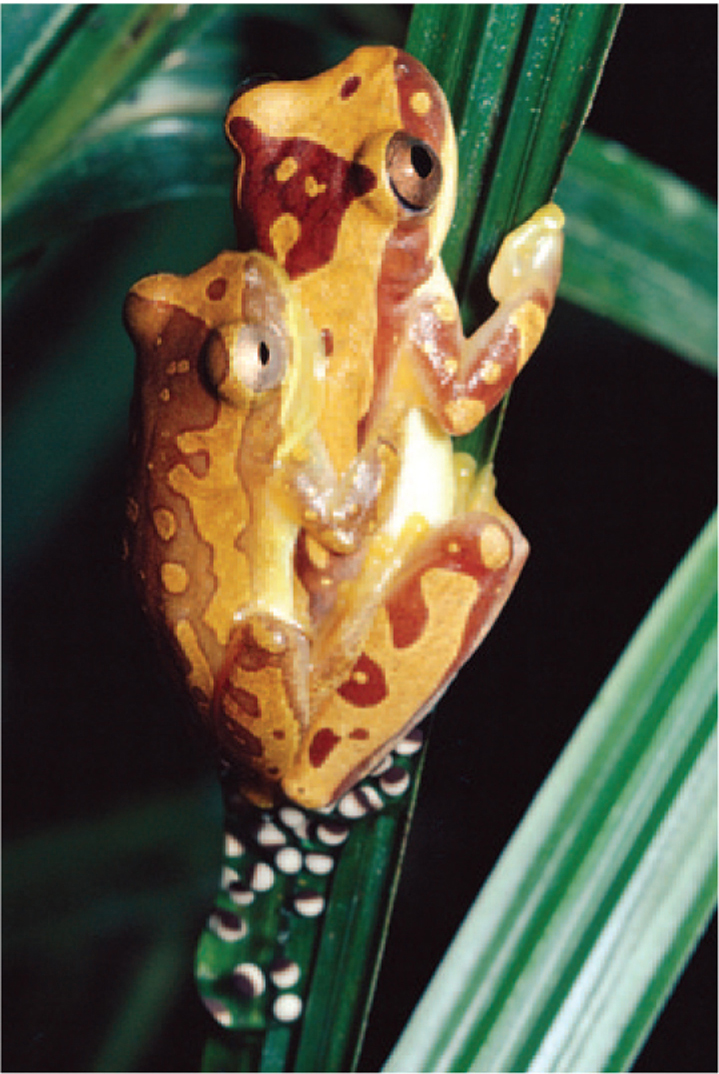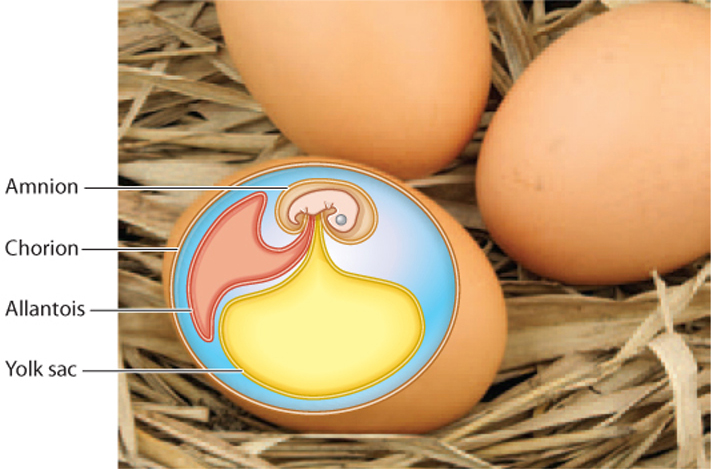42.2 MOVEMENT ONTO LAND AND REPRODUCTIVE ADAPTATIONS
We have considered the two modes of reproduction observed across all living organisms. In this section, we narrow our focus to vertebrates: fish, amphibians, reptiles, birds, and mammals. Interestingly, even among vertebrates, there are many different reproductive strategies. Understanding these strategies not only gives us a picture of how these organisms reproduce but also sheds light on how they live and behave.
How vertebrates reproduce is also intimately connected to the transition of vertebrates from water to land 375 to 400 million years ago. Moving from an aquatic environment to a terrestrial one involved many adaptations. Among these were changes in the way that reproduction took place, so it is helpful to consider reproductive strategies in an evolutionary context.
42.2.1 Fertilization can take place externally or internally.
Eggs and sperm require a wet environment to survive. In aquatic organisms like fish and amphibians, eggs and sperm can be released directly into the water in external fertilization. External fertilization, as you might imagine, is a chance affair: Somehow, sperm must meet egg in a large environment. Animals that release gametes externally therefore have developed strategies to increase the probability of fertilization. One strategy involves releasing large numbers of gametes. In addition, many female fish, including salmon and perch, lay eggs on or near a substrate, such as a rock, and males release their sperm onto the eggs to increase the probability of fertilization. Externally fertilizing animals may also come close together physically to improve chances that the sperm will fertilize the eggs. Male frogs grasp females, even though fertilization occurs externally, releasing sperm as the female lays her eggs (Fig. 42.7).

A challenge for land-dwelling organisms is how to keep gametes from drying out. Internal fertilization, in which fertilization takes place inside the body of the female, is an adaptation for living on land. Reptiles, birds, and mammals all use internal fertilization. However, this mode of fertilization is not exclusive to land dwellers. Marine mammals such as whales and dolphins use internal fertilization, as did the land-dwelling ancestors from which they evolved. Even some fish, such as guppies, reproduce by internal fertilization.
42.2.2 r-strategists and K-strategists differ in number of offspring and parental care.
While the terms “external” and “internal” fertilization focus our attention on where fertilization takes place, the two modes of reproduction are associated with a host of other behavioral and reproductive differences. One key difference is the number of offspring produced.
External fertilization is generally associated with the release of large numbers of gametes and the production of large numbers of offspring, each of which has a low probability of survival in part because the offspring typically receive little, if any, parental care. External fertilization is a game of numbers. In internal fertilization, however, there is much more control over fertilization and subsequent development of the embryo because both fertilization and embryonic development take place inside the female. As a result, animals that use internal fertilization typically produce far fewer offspring and invest considerable time and energy into raising those offspring.
These two strategies represent two ends of a continuum of reproductive strategies that was first described by the American ecologists Robert H. MacArthur and E. O. Wilson in 1967. Organisms that produce large numbers of offspring without a lot of parental investment are called r-strategists, and those that produce few offspring but put in a lot of parental investment are K-strategists (Fig. 42.8). Fish are r-strategists; humans are K-strategists.

According to this model, the environment places selective pressures on organisms to drive them in one or the other direction. In general, r-strategists evolve in unstable, changing, and unpredictable environments. In such an environment, there is an advantage to reproducing quickly and producing many offspring when conditions are favorable. By contrast, K-strategists often evolve in stable, unchanging, and predictable environments, where there tends to be more crowding and larger populations. Here, there is intense competition for limited resources, so traits such as increased parental care and few offspring are favored.
These two strategies represent ends of a spectrum, and there are notable exceptions. An octopus, for example, can lay up to 150,000 eggs, typical of r-strategists, but the female guards and takes care of them for a month or more, typical of K-strategists. However, the two strategies highlight different reproductive patterns across the animal kingdom and suggest important links between number of offspring, parental care, and the environment (Chapter 46).
42.2.3 Oviparous animals lay eggs, and viviparous animals give birth to live young.
When we speak of parental care, it is natural to think of tending the young. However, parental care actually begins much earlier in development, in the provisioning of nutrients for the developing embryo. The eggs of animals with external fertilization have a substance called yolk that provides all the nutrients that the developing embryo needs until it hatches. Water and oxygen are obtained directly from the aquatic environment and metabolic wastes easily diffuse out.

Animals that are internally fertilized can either lay eggs or give birth to live young. These two strategies are called oviparity (“egg birth”) and viviparity (“live birth”). Oviparity is used by fish and amphibians, as well as reptiles, birds, and most insects. Even some mammals—the monotremes, which include the spiny anteater and platypus—lay eggs. For oviparous animals there is very little, if any, embryonic development inside the mother, so all the nutrients for the developing embryo come from the yolk.
The movement onto land was associated with important changes in the anatomy of the egg. No longer could the developing embryo depend simply on diffusion of key substances into and out of a watery environment. A key innovation is the amnion, a membrane surrounding a fluid-filled cavity that allows the embryo to develop in a watery environment. Reptiles, birds, and mammals are known as amniotes to reflect the presence of this key membrane (Fig. 42.9). A second membrane, called the allantois, encloses a space where metabolic wastes collect. Finally, a third membrane, called the chorion, surrounds the entire embryo along with its yolk and allantoic sac. The embryo is further protected in many species by a hard shell that prevents drying out and facilitates gas exchange. The yolk sac, amnion, allantois, and chorion are extraembryonic membranes, sheets of cells that extend out from the developing embryo (Fig. 42.10).

Viviparous animals give birth to live young. Most mammals are viviparous, but viviparity is not unique to mammals; it evolved independently in several different groups. For example, some sharks and snakes are capable of giving birth to live young. In viviparous animals, the embryo develops inside the mother. In placental mammals, such as humans, the chorion and allantois fuse to form the placenta, an organ that allows nutrients to be obtained directly from the mother.